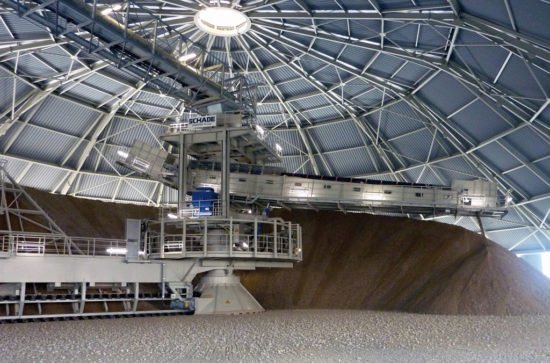Deployment at the Waste Incineration Plant
2. July 2025
AUMUND Group Field Service
Disassembly and Assembly of the Discharge System
The waste incineration plant has been in operation for over 50 years. It ensures the environmentally friendly treatment of waste, which is incinerated at temperatures of up to 1,200°C and primarily used for energy generation and district heating processes. Today, the plant is one of the largest of its kind in Germany.
The Besta & Meyer discharge system of the waste incineration plant is located at the gypsum silo (gypsum is a waste product of the flue gas desulphurisation process). The rotary chute is the central component that transfers the torque from the motors to the clearing arm within the silo. The clearing arm is, in turn, connected to the rotary chute by means of a flange. Over time, extensive wear and strong torsional forces caused the flange connection between the rotary chute and the clearing arm to tear. This resulted in significant damage to the rotary chute’s mounting for the clearing arm.
To avoid long downtimes, the plant operator decided to carry out emergency repairs to the rotary chute. A key aspect of the repair was that the rotary chute is a large and complex welded structure. Normally, it would be replaced as a complete module; however, due to delivery times for the components, this was not a viable option. Based on old drawings and an initial on-site inspection, the AUMUND Field Service team assessed the extent of the required repairs, including the necessary semi-finished products, connecting materials, and tools.
The actual work began with the disassembly of the three-part hopper, the chute, the motors, and the relocation of the pinion. The clearing arm inside the silo was first roughly separated from the heavily damaged rotary chute, then completely removed and replaced with a new clearing arm. A significant lack of space hindered the use of appropriate tools and complicated the dismantling of the drives and rotating chute. This was further exacerbated by the absence of attachment points inside the silo, which were essential for lifting the heavy machine parts with chain hoists. Additionally, positioning the dismantled heavy components on a solid surface became a balancing act. The old, damaged welded structure of the rotary chute could only be cut out in small steps—and, due to space constraints, by only one fitter.
During the subsequent assembly phase, particularly when cutting the rotating chute, the tools reached their material limits. The lack of attachment points also caused time problems when transporting parts: all new machine components, such as the rotating chute and the clearing arm, had to be lifted to the second floor using steel cable slings, then lowered to the lower floor for the actual assembly. Further adjustments of the new parts to the existing discharge system tested the repair team’s skill and expertise.
The AUMUND Field Service team completed the job following a successful cold commissioning. Two weeks later, the satisfied customer contacted us: the system is now running smoothly with material without any issues.
Contact
If we can help you with any further information, please use the contact form to get in touch.
You will receive an immediate automated acknowledgement, and we will respond to your enquiry as soon as possible.
Many thanks
AUMUND. SCHADE. SAMSON.














